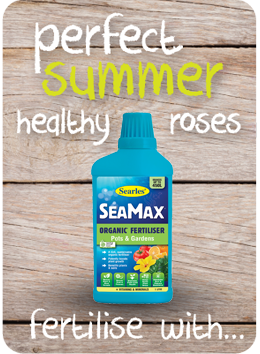How to care for Roses - Summer Rose Care
 |
|
Your rose bushes need special attention at this time of the year when the heat of summer puts them under a good deal of stress.
FUNGAL DISEASES AND PESTS ON ROSES When planting rose bushes, it is essential to space them far enough apart to allow for good air circulation all around. They should be planted in full sun away from other plants that will smother their stems and compete for moisture and nutrients. Hygiene is important: clean secateurs with a solution of bleach and water between each bush; never compost prunings, and remove any fallen foliage. It is generally best not to use chemicals in the garden, but choose instead one of the following organic and natural alternatives to stop fungal diseases. You can use lime sulphur diluted with water to the manufacturer's recommendations and sprayed over the stems and trunk. Apply this in the winter when the plant is dormant. Some organic growers have used milk and baking soda successfully. Simply mix half a litre of milk with two tablespoons of baking soda in five litres of water and spray liberally over foliage and stems. Apply at any time of the year. SeaMax Organic Fertiliser, which not only prevents fungal disease but also fertilise your plants at the same time. Professional rose growers have been using this excellent product for years with superb results, and it is now available for the convenience of home gardeners. Prune back the affected areas and apply SeaMax Organic Fertiliser. Rose Growers love it so much that SeaMax Organic Fertiliser is endorsed by The Qld Rose Society. White scale may appear on some bushes. This debilitating condition usually attacks the older wood so if the main part of the plant has lost its lush green colour and is not producing buds it might be time to prune the stem off at the base. The rest of the bush’s stems and lower ‘bud’ area should be sprayed each month with Searles Pest Gun, a white oil spray. This will suffocate the scale and while the bush will take on an even whiter appearance for a time, it should make a complete recovery. Do not use if shade temperatures exceed 32˚C.
WATERING ROSES Be mindful to adjust your watering regime throughout the different seasons. Increase watering during hot summer days and reduce during the winter months. Maintaining moisture at root level is also necessary and a deep watering at least weekly should be undertaken. More often if planted in pots. Mulching of beds will also assist in keeping the dampness of soil at the proper level. Look out for water-repellent soil, especially during summer. Tired soils and potting mixes with infrequent watering may lead to hydrophobic soil. When the soil is watered and the water pools on top and doesn't soak into the soil, the soil is considered hydrophobic. Sprinkle Searles Penetraide Re-wetting Granules onto the soil to promote better water absorption. This is ideal for pots and garden beds, as its benefits last for up to 12 months.
FERTILISING SUMMER ROSES It's important to apply fertiliser regularly to keep flowering strong. Apply Searles Rose & Flower Plant Food every season and liquid feed fortnightly with Searles Flourish Flower & Foliage Soluble Plant Food. Each week, the blooms which are not picked should be dead-headed by removing the spent flowers and then pruning the bush back to an outside bud. On mature bushes, it should be possible to prune to where the stem is about the thickness of a standard pencil, but you should go more lightly on younger bushes that are still developing. Don’t prune heavily during the heat of February, as this will put the bushes under unnecessary stress. |
 |




